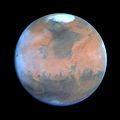Ficheiro:Mars atmosphere by Hubble.jpg

Ficheiro original (800 × 800 píxeis, tamanho: 30 kB, tipo MIME: image/jpeg)
Este ficheiro vem da wiki Wikimedia Commons e pode ser usado por outros projetos. A descrição na página original de descrição do ficheiro é mostrada abaixo.
Descrição do ficheiro
| DescriçãoMars atmosphere by Hubble.jpg |
English: This NASA Hubble Space Telescope view of the planet Mars is the clearest picture ever taken from Earth, surpassed only by close-up shots sent back by visiting space probes. The picture was taken on February 25, 1995, when Mars was at a distance of approximately 65 million miles (103 million km) from Earth.
Because it is spring in Mars' northern hemisphere, much of the carbon dioxide frost around the permanent water-ice cap has sublimated, and the cap has receded to its core of solid water-ice several hundred miles across. The abundance of wispy white clouds indicates that the atmosphere is cooler than seen by visiting space probes in the 1970s. Morning clouds appear along the planet's western (left) limb. These form overnight when Martian temperatures plunge and water in the atmosphere freezes out to form ice-crystal clouds. Towering 16 miles (25 km) above the surrounding plains, volcano Ascraeus Mons pokes above the cloud deck near the western or limb. This extinct volcano, measuring 250 miles (402 km) across, was discovered in the early 1970s by Mariner 9 spacecraft. Other key geologic features include (lower left) the Valles Marineris, an immense rift valley the length of the continental United States. Near the center of the disk lies the Chryse basin made up of cratered and chaotic terrain. The oval-looking Argyre impact basin (bottom), appears white due to clouds or frost. Seasonal winds carry dust to form striking linear features reminiscent of the legendary martian "canals." Many of these "wind streaks" emanate from the bowl of these craters where dark coarse sand is swept out by winds. Hubble resolves several dozen impact craters down to 30-mile diameter. The dark areas, once misinterpreted as regions of vegetation by several early Mars watchers, are really areas of coarse sand that is less reflective than the finer, orange dust. Seasonal changes in the surface appearance occur as winds move the dust and sand around. This picture was taken with Hubble's Wide Field Planetary Camera 2 in PC mode. Exposures were taken through three different color filters to create this true color image. The pictures were map-projected onto a sphere for accurate registration and perspective. |
| Data | |
| Origem | http://hubblesite.org/newscenter/archive/releases/1995/16/image/b/ |
| Autor | Philip James (University of Toledo), Steven Lee (University of Colorado), NASA |
Licenciamento
| Public domainPublic domainfalsefalse |
| Este ficheiro está no domínio público nos Estados Unidos porque foi criado exclusivamente pela NASA. As orientações sobre o direito de autor da NASA são que «as obras da NASA não têm os direitos de autor protegidos salvo indicação em contrário». Veja Template:PD-USGov, as orientações sobre o direito de autor da NASA ou as normas de uso de imagens do Laboratório de Propulsão a Jato (Jet Propulsion Lab, JPL). |  | |
 |
Avisos:
|
Legendas
Elementos retratados neste ficheiro
retrata
24 agosto 2014
Histórico do ficheiro
Clique uma data e hora para ver o ficheiro tal como ele se encontrava nessa altura.
| Data e hora | Miniatura | Dimensões | Utilizador | Comentário | |
|---|---|---|---|---|---|
| atual | 18h38min de 24 de agosto de 2014 |  | 800 × 800 (30 kB) | Faduart | User created page with UploadWizard |
Utilização local do ficheiro
A seguinte página usa este ficheiro: